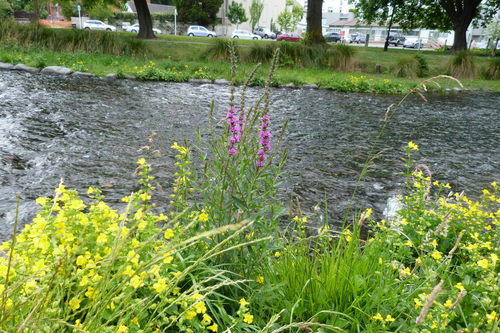Purple loosestrife
Lythrum salicariaSummary 6
Lythrum salicaria (purple loosestrife or spiked loosestrife) is a flowering plant belonging to the Lythraceae family. The flowers and stems are both reddish-purple and the plant also produces a small fruit measuring 1-2 mm. It is native to Europe, Asia, northwest Africa, and southeastern Australia and grows well in ditches.
Botanical Information 7
The purple loosestrife has a square stem and leaves that spiral along the sides of the stem. The purple flowers sprout at the top of the stem in a spire similar to lavender. This plant can grow from 3 feet to 7 feet in height. You can find this plant in marshlands and swamps usually on the shore of the large body of water, although it will sometimes be found inside the water. This plant blooms from July through September.
Ecological Information 6
The purple loosestrife is considered invasive because it tends to crowd out other plants by taking over available water and land. The plant can also crowd out small animals by displacing food sources and nesting grounds. Purple loosestrife prefers to grow in moist soil but can grow in poor soil conditions. It spreads by seed with a high seed germination rate.
Ethnobotanical Information 6
The beautiful purple leaves of this plant can be used as a red dye. The purple loosestrife leaves and stems can be cooked and eaten for its drying properties to help with stomach issues. According to the USDA, purple loosestrife was purposely introduced into North America by immigrants to help treat dysentery and bleeding, as well as for decoration and planted by beekeepers as a food source for bees.
References 8
Mcdonald, J. (n.d). Purple Loosestrife. Herbcraft. Retrieved November 9, 2021, from http://www.herbcraft.org/loosestrife.html
National Invasive Species Information Center (n.d). Purple Loosestrife. U.S. Department of Agriculture. Retrieved November 9, 2021, from https://www.invasivespeciesinfo.gov/aquatic/plants/purple-loosestrife#cit
United States Department of Agriculture. (2014). Lythrum salicaria L.. In
PLANTS Database. Retrieved November 18, 2021, from https://plants.usda.gov/home/plantProfile?symbol=LYSA2
About the Author 6
Student author(s)*: Israel and Linden (age 14) from Albuquerque Sign Language Academy
*The entries in this field guide have been edited by Yerba Mansa Project staff to ensure that they contain quality, fact-checked content and standardized formatting. https://yerbamansaproject.org/
Sources and Credits
- (c) Chris Rimmer, some rights reserved (CC BY-NC), uploaded by Chris Rimmer
- (c) Colin Meurk, some rights reserved (CC BY-SA), uploaded by Colin Meurk
- (c) David Yeany, some rights reserved (CC BY-NC), uploaded by David Yeany
- (c) botanygirl, some rights reserved (CC BY), uploaded by botanygirl
- (c) Станислав, some rights reserved (CC BY-NC), uploaded by Станислав
- Adapted by albuquerqueherbalism from a work by (c) smiller33, some rights reserved (CC BY-SA)
- Adapted by smiller33 from a work by (c) Wikipedia, some rights reserved (CC BY-SA), https://en.wikipedia.org/wiki/Lythrum_salicaria
- Adapted by Kiley Spurlock from a work by (c) smiller33, some rights reserved (CC BY-SA)
More Info
- iNat taxon page
- African Plants - a photo guide
- Atlas of Living Australia
- Biodiversity Heritage Library
- BOLD Systems BIN search
- Calflora
- CalPhotos
- Catalogo de Plantas y Líquenes de Colombia
- eFloras.org
- Flora Digital de Portugal
- Flora of North America (beta)
- Global Biodiversity Information Facility (GBIF)
- Go Botany
- HOSTS - a Database of the World's Lepidopteran Hostplants
- IPNI (with links to POWO, WFO, and BHL)
- Jepson eFlora
- Maryland Biodiversity Project
- NatureServe Explorer 2.0
- NBN Atlas
- New Zealand Plant Conservation Network
- OregonFlora.org
- SEINet Symbiota portals
- Tropicos
- USDA PLANTS database
- VASCAN by Canadensys
- World Flora Online
- 日本のレッドデータ検索システム
- 植物和名−学名インデックス YList
iNat Map
| Type | herb |
|---|---|
| Uses | dye, medicinal |
| Flower | purple |
| Life cycle | perennial |
| Native | no |
| Habitat | Wetlands |










